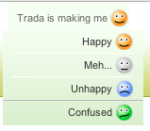Measuring customer satisfaction
 There was a great thread this week on the Foundry CEO email list about Net Promoter Score and how companies are using it to measure the satisfaction of their customers (specifically in the case of NPS, their propensity to recommend the product or service to others). NPS can be a useful tool when used properly (which was much of the discussion on the email thread – who to measure, how often, etc.). But NPS can be cumbersome to measure, hard to understand granularly and not very helpful in letting you know what any given customer is really thinking about their interactions with your company (other than the extreme outliers).
There was a great thread this week on the Foundry CEO email list about Net Promoter Score and how companies are using it to measure the satisfaction of their customers (specifically in the case of NPS, their propensity to recommend the product or service to others). NPS can be a useful tool when used properly (which was much of the discussion on the email thread – who to measure, how often, etc.). But NPS can be cumbersome to measure, hard to understand granularly and not very helpful in letting you know what any given customer is really thinking about their interactions with your company (other than the extreme outliers).
The discussion and thinking about both the benefits and limitations of NPS got me thinking about a clever way that Trada measures customer satisfaction in their app on a customer by customer basis that I thought was worth passing along.
On most pages in the Trada app (Trada has a b-to-b focused application but this advice holds for b-to-c as well), there’s a small smiley face in the nav bar. It can exist in only one of four states – Happy, Meh…, Unhappy or Confused. It can only be set by the customer themselves (the admin login that the Trada customer service team uses doesn’t allow them to change the state) and customers are regularly prompted to update its status (which does not start “happy” so there’s no bias to just leaving it alone). It’s amazing how powerful such a simple idea has been for keeping tabs on how individual customers are feeling about their interactions with Trada and its application. It’s easy enough to use that customers engage with it. It can only exist in a limited number of states so it gets ride of the gravitation away from the edge that larger measurement scales tend to product, and is a great early sign to Trada’s customer service team that something is wrong with a client. The company uses data from this metric to reach out proactively to customers who are expressing confusion or dissatisfaction with their work on the platform. For Trada this doesn’t replace measuring NPS, which gives management a higher level view of overall customer satisfaction) but has been an extremely effective tool to help them deliver a fantastic customer experience.
Sometimes simple solutions can be very effective.

